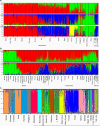The ascent of cat breeds: genetic evaluations of breeds and worldwide random-bred populations
- PMID: 18060738
- PMCID: PMC2267438
- DOI: 10.1016/j.ygeno.2007.10.009
The ascent of cat breeds: genetic evaluations of breeds and worldwide random-bred populations
Abstract
The diaspora of the modern cat was traced with microsatellite markers from the presumed site of domestication to distant regions of the world. Genetic data were derived from over 1100 individuals, representing 17 random-bred populations from five continents and 22 breeds. The Mediterranean was reconfirmed to be the probable site of domestication. Genetic diversity has remained broad throughout the world, with distinct genetic clustering in the Mediterranean basin, Europe/America, Asia and Africa. However, Asian cats appeared to have separated early and expanded in relative isolation. Most breeds were derived from indigenous cats of their purported regions of origin. However, the Persian and Japanese bobtail were more aligned with European/American than with Mediterranean basin or Asian clusters. Three recently derived breeds were not distinct from their parental breeds of origin. Pure breeding was associated with a loss of genetic diversity; however, this loss did not correlate with breed popularity or age.
Figures




References
-
- Vigne JD, Guilaine J, Debue K, Haye L, Gerard P. Early taming of the cat in Cyprus. Science. 2004;304:259. - PubMed
-
- Dobney K, Larson G. Genetics and animal domestication: new windows on an elusive process. Journal of Zoology. 2006;269:261–271.
-
- Gupta AK. Origin of agriculture and domestication of plants and animals linked to early Holocene climate amelioration. Current Science. 2004;87:54–59.
-
- Zohary D, Hopf M. Domestication of Plants in the Old World. Oxford University Press; Oxford: 2000.
-
- Bradshaw JWS, Horsfield GF, Allen JA, Robinson IH. Feral cats: their role in the population dynamics of Felis catus. Applied Animal Behaviour Science. 1999;65:273–283.
Publication types
MeSH terms
Grants and funding
LinkOut - more resources
Full Text Sources
Miscellaneous

